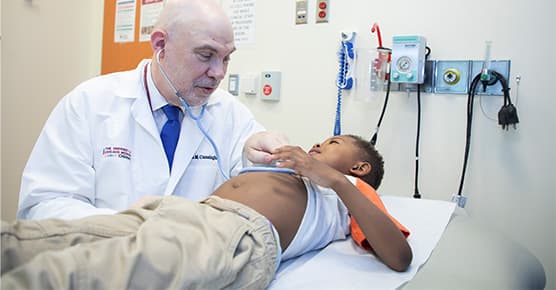Pediatric Retinoblastoma Care
The University of Chicago Medicine Comer Children’s Hospital provides comprehensive care for children with retinoblastoma, a rare — but highly curable — cancer of the eye. Our pediatric cancer care team and pediatric ophthalmologists offer state-of-the-art diagnostic and treatment services.
Advanced Expertise
As active members of the Children’s Oncology Group (COG), our physicians network with more than 250 medical centers worldwide. We participate in clinical trials of the newest, most promising treatments for all childhood cancers, including retinoblastoma.
About 40 percent of retinoblastomas are hereditary. The highly specialized Familial Cancer Clinic at the Comer Children's offers genetic testing and counseling for retinoblastoma patients and their families.
Services
Comer Children’s offers complete diagnosis and treatment for retinoblastoma. As one of the busiest pediatric cancer programs in the Midwest, we have the expertise and resources to care for children with any type of retinoblastoma.
Diagnosis
The first step in diagnosing retinoblastoma is an ophthalmoscopic eye exam performed by a pediatric ophthalmologist. With the child under general anesthesia, the pupils are dilated so the entire retina can be examined to determine the location, size and extent of the eye tumor. The exam is followed by a CT scan and/or MRI scan to look for involvement of tissues outside of the eye. The scans also help confirm the diagnosis of retinoblastoma.
When tissue samples are taken, pathologists at the University of Chicago Medicine confirm the diagnosis and assist in the process of procuring tumor tissue for genetic testing.
Treatment
The treatment for retinoblastoma is individualized for each patient depending on factors such as involvement of one or both eyes, tumor size, location and the stage of the disease. The primary goal is to treat the tumor and stop the spread of the cancer. The treatment plan is designed to save the eye and vision whenever possible. For each patient, the ophthalmologist, medical oncologist and radiation oncologist design a treatment plan that may include the following:
- Laser treatment
- Cryotherapy (freezing treatment)
- Chemotherapy
- Radiation
- Enucleation surgery (removal of the eye)
Some children will be eligible to participate in clinical trials. These treatment protocols are part of a nationwide, National Cancer Institute-sponsored effort to evaluate and monitor newer therapies.



